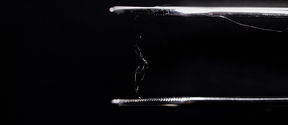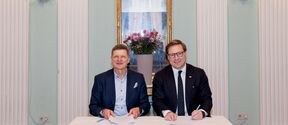Aalto University presents six concepts on renewable biomaterials at Dutch Design Week
CHEMARTS exhibition showcases fascinating recyclable prototypes which are toxic-free, recyclable and don't release micro-plastics.

Already four years ago Li Edelkoort declared fashion has become old fashioned, as the fast fashion business models have broken the system. However, she thinks, we’ll still need textiles, but in a novel ways. ‘In the future, textiles will go anywhere. They could be the main material in building, health and many more, that we can’t think of yet. Textiles offer endless possibilities to change the world’, says Li Edelkoort, a world-known trend forecaster who spoke in the Textiles Tomorrow Summit in Espoo, hosted by Aalto University last week.
This was the second summit initiated by Edelkoort, Associate Provost and Dean of Hybrid Design Studies in Parsons School of Design, New York, and it gathered an international network of textile educators and professionals to discuss the future of textiles and share knowledge and expertise.
In the 21st century, Edelkoort predicts, textiles can become main material in manufacturing, even ‘skins’ of buildings, though we’re not yet there. There will be advanced textile techniques: maybe huge robots knitting and 3D-printing on textiles and tapestries.
Quite passionately, yet with a peaceful, low tone of voice, Edelkoort talks about textiles and their opportunities to save the world. She anticipates future fashion and design trends and wants people to understand that we need to make a change.
In her vividly visual presentation she lifts up a number of current trends and reflects them to the past. Li Edelkoort stresses the importance of doing research in history. Anthropology is strategy, she says, and archeology is exploration – these are needed as tools to understand what textiles are.
In design and fashion there is keen interest to find ancient techniques. Edelkoort encourages her students to research and get inspired by the indigenous textiles from times back, and see what they can offer for today. She calls us to understand the relation with people and their textiles.
‘We are living in such chaotic and barbaric time, that it is hard to be human. Yet, this fragmentation is also strangely inspiring us.’
She says design is becoming hybrid: different disciplines mix and turn into a new one. Her students are exploring what becomes when textile designer meets architect, or an activist, gardener, chef, illustrator, colorist, artist, storyteller, nomad…
Marketing has had its best days, Edelkoort points out. Understanding the consumer becomes essential.
Li EdelkoortI have decided to vote on us people, we’re intelligent and capable.’
A big topic of today is the role of animals. One thing is clear: we can’t use furs anymore. The question is, what can we learn from the animals and how can we use the plants better.
To Edelkoort quality means learning: how can we save our planet? Natural materials like peat or spider silks can turn into new products. Use of hair, feathers, mushrooms, fibers from sea like algae, or pine trees, old flowers, all have potential. For example spider silk could totally replace the synthetic materials and seaweed could replace leather. The problem is that research and development processes take years, and we desperately need new solutions already now.
Also, Edelkoort wants to point out the role of colours: they could make a concept themselves. Her students can do their final work on colours only. Also, worth noting is that industry on colours is vast, enormous. It’s a field we’re not aware of yet, she says, a field of possibilities in itself, and for a career.
Along with colours dyeing is the next big thing: the focus will be on dyeing with food and waste. Edelkoort sees intelligent use of colour coming up, natural dyeying, made with plants, and recycling.
‘In the future the colours might be lighter and slighter. This thinking and techniques will penetrate the market with the students when they get into profession’, Edelkoort predicts.
Edelkoort refers to recent Dutch Design Week in Eindhoven, the Netherlands, where a pavilion made of mushroom was presented. The pavilion, as well as several exhibitions during the design week, showcased wild experiments with all natural materials like linen, seaweed or even horse manure. This, according to Edelkoort, predicts we are entering a future where nothing is synthetic or glued.
The change and need for it has been fast. Now more and more retailers are requesting sustainable materials. Edelkoort tells about her client on rugs industry in Denmark, who says it has changed in just half a year. Now all needs to be recycled and no-waste. Also large companies are trying to get into the mood of recycling.
But, because of enlargening critical mass, maybe a new door is opening. Recycling to Edelkoort means also reincarnation: something completely different. Waste no more. Upcycling instead of just recycling.
Li Edelkoort sums it up by saying she believes in the future. Continuing doing what we are, we will be killing ourselves. Yet we need critical creative solutions, she says – how to turn our shit around. She has been pondering whether we people are intelligent enough to change the course.
‘Think about what will happen in ten to fifteen years? I have decided to vote on us people, we’re intelligent and capable.’
‘What an amazing world, that we can save with textiles! Fashion and arts, the whole world is suffering due to greed. Circular society starts with textiles. It all starts with us, textilers. It’s a beautiful opportunity. We are the firefighters.’
***
The summit brought together around 200 textile academics, professors and lecturers from 14 countries and 28 different universities and educational institutions as well as students and textile professionals from the industry and businesses. Aside the talks, networking and collaboration, the two-day summit offered exhibitions at the Aalto University Campus, the book launch Interwoven - Exploring Materials and Structures at Espoo modern art museum EMMA and company visits.The exhibition Interwoven - Exploring Materials and Structures at EMMA features 12 artists and is open until 1 March 2020.
Textiles Tomorrow Summit(30.-31.10.2019)

CHEMARTS exhibition showcases fascinating recyclable prototypes which are toxic-free, recyclable and don't release micro-plastics.

The unique material outperforms most of today’s synthetic and natural materials by providing high strength and stiffness, combined with increased toughness

Crops4Luxury (PeltoLuksus) project studied special crops that could replace synthetic textile dyes sustainably and ethically



